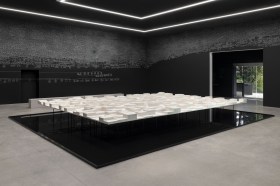Harewood House offers visitors the usual experiences we anticipate from country houses: stunning grounds, architecture and interiors. But, visitors be warned and prepare for an unexpected encounter! Listen for the comments as you queue to enter the house: “… avert your eyes dear”. Nowhere is the collision between the Modern and the Classical more clearly focused than in the grand entrance hall of Harewood House, an elegant and opulent space decorated in a rococo style punctuated by niches housing Victorian marble portrait busts, elegant Chippendale chairs and a pair of large seventeenth century Chinese vases. The lavish ceilings, friezes and chimney pieces designed by Robert Adams provide a refined and unified decorative programme.
.JPG)
Displayed in arguably the most important location of the house – as the centrepiece of this grand entrance hall – is Adam by Sir Jacob Epstein, a work that has the potential to shock and challenge unsuspecting visitors. The blatant and unashamed depiction of primal energy and sexuality attracted much press coverage, shock and outrage when the work was first exhibited in the late 1930s. It continues to divide opinion amongst Harewood’s visitors today. As the focal point of the space into which people arrive to begin their exploration of the house, it demands visitors’ attention” love it or loathe it, you cannot help but encounter it en route to the rest of the house. The long-established male nude subject, rooted in the classical tradition and its notions of ideal beauty and conventional masculinity are subverted here in the monumental, heroically proportioned Adam. Biblical convention is similarly subverted in this representation of the first man as primitive fertility idol. This emphasis on the primal instinctive aspects of human experience is difficult to reconcile with the religious theme referenced in the title.
Jacob Epstein owned a vast and diverse ethnographic collection containing Egyptian, Assyrian, Oceanic and African artefacts. The influence of this collection pervades Adam and works from this period like Jacob and the Angel, now a prized work in the prestigious Tate collection. The angular line of the hair, for example, suggests Egyptian sculpture whilst the muscular torso is comparable to the heroic western depictions of mythological gods or giants. The pose is not a peaceful moment of stillness and reflection as one may expect in a figure apparently contemplating divine forces” rather, great energy and movement are conveyed in Adam. There seems great tension between the immensity and heaviness of the lower body and the upward thrust of the pose which culminates in the upturned face.
Whilst the figure is distorted, simplified and abstracted, a sense of humanity remains. Human proportions are maintained through the attention to anatomical detail and muscular definition. Yet this is an heroic depiction of the first man – its overt sexuality, dynamism and domination over viewers is what makes the work either awe-inspiring or obscene. Epstein was widely known for his sculptural practice based on ideas of the sacred and the profane. He was one of the main proponents of the Direct Carving movement that included the giants of twentieth century British sculpture Henry Moore and Barbara Hepworth. Epstein’s Adam conveys a number of elements central to Direct Carving. Much of the surface is highly worked to a smooth glossy finish, enriching the natural colouring and veining of the alabaster. The rich hues, ranging from pale creams through earthy reds and oranges to dark browns, have varying degrees of translucency and react to the light as you move around the work. Direct Carvers were obsessed with the notion of ‘truth to materials’ and with retaining as much of the original block as possible. Even those who find the aesthetics of the work distasteful could not deny the delicacy and beauty of the material from which it is carved.

The opulence of the work’s current surroundings strongly contrasts with previous display contexts. As an un-commissioned, challenging work of sculpture, it attracted many visitors when first exhibited but was virtually un-saleable. It was eventually sold to a showman who recognised its voyeuristic potential. It was toured as part of an adults-only peepshow before being sold on to Louis Tussaud’s in Blackpool where it remained as part of a titillating display for adults in the basement. Here it remained until the 1960s when its status as a serious work of Modernist sculpture was revived when Lord Harewood ‘rescued’ it from obscurity exhibiting it at the National Gallery of Scotland during the Edinburgh Festival before its arrival in the collection at Harewood. The guidebook notes that “the degree to which Epstein’s Adam fits into Robert Adam’s overall decorative scheme may intrigue the visitor.” For me, the story of the sculpture’s reception and somewhat chequered history adds to my appreciation of the curatorial bravery in the choice of exhibition location. I am glad it has pride of place and is not tucked away in a corner somewhere.




